River Stage Modeling by Combining Maximal Overlap Discrete Wavelet Transform, Support Vector Machines and Genetic Algorithm
Abstract
:1. Introduction
2. Materials and Methods
2.1. Data Used
2.2. Discrete Wavelet Transform (DWT)
2.3. Maximal Overlap Discrete Wavelet Transform (MODWT)
2.4. Multilayer Perceptron (MLP)
2.5. Support Vector Machine (SVM)
2.6. Genetic Algotrithm (GA)
- Step 1. Generate an initial random population .
- Step 2. Compute the fitness of each chromosome in the population, and assign probability typically proportional to the fitness.
- Step 3. Reproduce new population using selection, crossover and mutation operators.
- Step 4. Repeat from step 2 to step 3 until stop conditions are met. The algorithm yields as the optimum.
2.7. River Stage Modeling Using DWT and MODWT
- Step 1. Decompose original input signals into sub-signals (detail and approximation components) utilizing DWT and MODWT.
- Step 2. Select effective inputs among the sub-signals.
- Step 3. Train and test single models, MLP and SVM, utilizing the effective inputs.
2.8. Model Efficiency Evaluation
- -
- Dimensionless indices: coefficient of efficiency (CE), index of agreement (d) and coefficient of determination (r2)
- -
- Residual error-based indices: root-mean-square error (RMSE), mean absolute error (MAE), mean squared relative error (MSRE) and mean higher order error (MS4E)
2.9. Model Effectiveness Evaluation
3. Results and Discussion
3.1. Model Development
3.2. Model Performance Assessment
3.3. Graphical Comparison
4. Conclusions
- (1)
- For the overall stage, the MODWT–SVM models achieve better efficiency and effectiveness based on the statistical indices, and are more accurate than the single models based on the graphical comparison. For the low, medium and high stages, the MODWT–SVM models perform better than the single models, in terms of efficiency and effectiveness. These results indicate that the conjunction of MODWT, SVM and GA can improve the performance of SVM models and outperform single models in daily river stage modeling.
- (2)
- For the overall stage, the MODWT–SVM models achieve better efficiency and effectiveness based on the statistical indices, and are more accurate than the MODWT–MLP and DWT-based models based on the graphical comparison. For the low and high stages, the MODWT–SVM models performed better than the MODWT–MLP and DWT-based models, in terms of efficiency and effectiveness. For the medium stage, the DWT–MLP models outperform the MODWT–SVM models, in terms of the statistical indices. These results demonstrate that the MODWT–based models using the SVM model can improve model performance and accuracy better than those using the MLP model in daily river stage modeling. Also, hybrid models coupling MODWT, SVM and GA can enhance model performance and accuracy in daily river stage modeling as compared with those combined with DWT.
- (3)
- The MODWT–SVM2–c12 model achieves the best efficiency for the overall, low and high stages, based on the efficiency indices; the MODWT–SVM1–c12 model for the low stage; the DWT–MLP1–d18 model for the medium stage; and the MODWT–SVM1–s18 model for the high stage. Also, the MODWT–SVM1–c12 model achieves the best effectiveness for the overall and low stages; the MODWT–SVM2–c12 model for the overall, low, medium and high stages; and the MODWT–SVM1–s18 model for the high stage. These results indicate that the performance of the MODWT–SVM models is dependent on input combination and mother wavelets. Furthermore, the MODWT–SVM model using the c12 mother wavelet can improve model efficiency and effectiveness in daily river stage modeling. Therefore, the results obtained from this study demonstrate that the conjunction of MODWT, SVM and GA can be an efficient and effective method for modeling daily river stages.
Author Contributions
Conflicts of Interest
Appendix A. Model Efficiency Indices
- Coefficient of efficiency (CE): ,
- Index of agreement (d): ,
- Coefficient of determination (r2): ,
- Root-mean-square error (RMSE): ,
- Mean absolute error (MAE): ,
- Mean squared relative error (MSRE): ,
- Mean higher order error (MS4E): ,
Appendix B. Model Effectiveness Indices
- Average absolute relative error (AARE): ,
- Threshold statistics (TS): ,
References
- Besaw, L.E.; Rizzo, D.M.; Bierman, P.R.; Hackett, W.R. Advances in ungauged streamflow prediction using artificial neural networks. J. Hydrol. 2010, 386, 27–37. [Google Scholar] [CrossRef]
- Kim, S.; Shiri, J.; Kisi, O. Pan evaporation modeling using neural computing approach for different climatic zones. Water Resour. Manag. 2012, 26, 3231–3249. [Google Scholar] [CrossRef]
- Awchi, T.A. River discharges forecasting in northern Iraq using different ANN techniques. Water Resour. Manag. 2014, 28, 801–814. [Google Scholar] [CrossRef]
- Chen, L.; Singh, V.P.; Guo, S.; Zhou, J.; Ye, L. Copula entropy coupled with artificial neural network for rainfall-runoff simulation. Stoch. Environ. Res. Risk Assess. 2014, 28, 1755–1767. [Google Scholar] [CrossRef]
- Daliakopoulos, L.N.; Tsanis, L.K. Comparison of an artificial neural network and a conceptual rainfall-runoff model in the simulation of ephemeral streamflow. Hydrol. Sci. J. 2016, 61, 2765–2774. [Google Scholar] [CrossRef]
- Ehsani, N.; Fekete, B.M.; Vörösmarty, C.J.; Tessler, Z.D. A neural network based general reservoir operation scheme. Stoch. Env. Res. Risk Assess. 2016, 30, 1151–1166. [Google Scholar] [CrossRef]
- Safari, M.-J.-S.; Aksoy, H.; Mohammadi, M. Artificial neural network and regression models for flow velocity at sediment incipient deposition. J. Hydrol. 2016, 541, 1420–1429. [Google Scholar] [CrossRef]
- Seo, Y.; Kim, S.; Kisi, O.; Singh, V.P. Daily water level forecasting using wavelet decomposition and artificial intelligence techniques. J. Hydrol. 2015, 520, 224–243. [Google Scholar] [CrossRef]
- Seo, Y.; Kim, S.; Kisi, O.; Singh, V.P.; Parasuraman, K. River stage forecasting using wavelet packet decomposition and machine learning models. Water Resour. Manag. 2016, 30, 4011–4035. [Google Scholar] [CrossRef]
- Adamowski, J.; Sun, K. Development of a coupled wavelet transform and neural network method for flow forecasting of non-perennial rivers in semi-arid watershed. J. Hydrol. 2010, 390, 85–91. [Google Scholar] [CrossRef]
- Kisi, O.; Shiri, J.; Nazemi, A.H. A wavelet-genetic programming model for predicting short-term and long-term air temperatures. J. Civ. Eng. Urban. 2011, 1, 25–37. [Google Scholar]
- Okkan, U.; Serbes, Z.A. The combined use of wavelet transform and black box models in reservoir inflow modeling. J. Hydrol. Hydromech. 2013, 61, 112–119. [Google Scholar] [CrossRef]
- Ravikumar, K.; Tamilselvan, S. On the use of wavelets packet decomposition for time series prediction. Appl. Math. Sci. 2014, 8, 2847–2858. [Google Scholar] [CrossRef]
- Raghavendera, N.S.; Deka, P.C. Forecasting monthly groundwater level fluctuations in coastal aquifers using hybrid wavelet packet-support vector regression. Cogent Eng. 2015, 2, 999414. [Google Scholar] [CrossRef]
- Cornish, C.R.; Bretherton, C.S.; Percival, D.B. Maximal overlap wavelet statistical analysis with application to atmospheric turbulence. Bound.-Layer Meteorol. 2006, 119, 339–374. [Google Scholar] [CrossRef]
- Tiwari, M.K.; Chatterjee, C. Development of an accurate and reliable hourly flood forecasting model using wavelet-bootstrap-ANN (WBANN) hybrid approach. J. Hydrol. 2010, 394, 458–470. [Google Scholar] [CrossRef]
- Nason, G. Wavelet Methods in Statistics with R; Springer: New York, NY, USA, 2008; ISBN 978-0-387-75961-6. [Google Scholar]
- Mallat, S.G. A theory for multiresolution signal decomposition: the wavelet representation. IEEE Trans. Pattern Anal. Mach. Intell. 1989, 11, 674–693. [Google Scholar] [CrossRef]
- Percival, D.B.; Walden, A.T. Wavelet Methods for Time Series Analysis; Cambridge University Press: Cambridge, UK, 2000; ISBN 978-0-521-68508-5. [Google Scholar]
- Nourani, V.; Alami, M.T.; Aminfar, M.H. A combined neural-wavelet model for prediction of Ligvanchai watershed precipitation. Eng. Appl. Artif. Intell. 2009, 22, 466–472. [Google Scholar] [CrossRef]
- Günther, F.; Fritsch, S. Neuralnet: Training of neural networks. R J. 2010, 2, 30–38. [Google Scholar]
- Vapnik, V.N. Statistical Learning Theory; Wiley: New York, NY, USA, 1998; ISBN 978-0-471-03003-4. [Google Scholar]
- Noori, R.; Karbassi, A.R.; Moghaddamnia, A.; Han, D.; Zokaei-Ashtiani, M.H.; Farokhnia, A.; Ghafari Gousheh, M. Assessment of input variables determination on the SVM model performance using PCA, gamma test and forward selection techniques for monthly stream flow prediction. J. Hydrol. 2011, 401, 177–189. [Google Scholar] [CrossRef]
- Sivanandam, S.N.; Deepa, S.N. Introduction to Genetic Algorithms; Springer: Berlin, Germany, 2007; ISBN 978-3-540-73189-4. [Google Scholar]
- Scrucca, L. GA: A package for genetic algorithms in R. J. Stat. Softw. 2013, 53, 1–37. [Google Scholar] [CrossRef]
- Obitko, M. Introduction to Genetic Algorithms. 1998. Available online: http://www.obitko.com/tutorials/genetic-algorithms/ (accessed on 28 June 2017).
- Dawson, C.W.; Wilby, R.L. Hydrological modelling using artificial neural networks. Prog. Phys. Geogr. 2001, 25, 80–108. [Google Scholar] [CrossRef]
- Dawson, C.W.; Abrahart, R.J.; See, L.M. HydroTest: A web-based toolbox of evaluation metrics for the standardised assessment of hydrological forecasts. Environ. Model. Softw. 2007, 22, 1034–1052. [Google Scholar] [CrossRef]
- Jain, A.; Srinivasulu, S. Development of effective and efficient rainfall-runoff models using integration of deterministic, real-coded genetic algorithms and artificial neural network techniques. Water Resour. Res. 2004, 40, W04302. [Google Scholar] [CrossRef]
- Srinivasulu, S.; Jain, A. A comparative analysis of training methods for artificial neural network rainfall-runoff models. Appl. Soft Comput. 2006, 6, 295–306. [Google Scholar] [CrossRef]
- Jain, A.; Kumar, A.M. Hybrid neural network models for hydrologic time series forecasting. Appl. Soft Comput. 2007, 7, 585–592. [Google Scholar] [CrossRef]
- Panagoulia, D.; Tsekouras, G.J.; Kousiouris, G. A multi-stage methodology for selecting input variables in ANN forecasting of river flows. Glob. NEST J. 2017, 19, 49–57. [Google Scholar]
- Wu, C. Hydrological Predictions Using Data-Driven Models Coupled with Data Preprocessing Techniques. Ph.D. Thesis, The Hong Kong Polytechnic University, Kowloon, Hong Kong, 2010. [Google Scholar]
- Venables, W.N.; Ripley, B.D. Modern Applied Statistics with S, 4th ed.; Springer: New York, NY, USA, 2002; ISBN 978-0-387-21706-2. [Google Scholar]
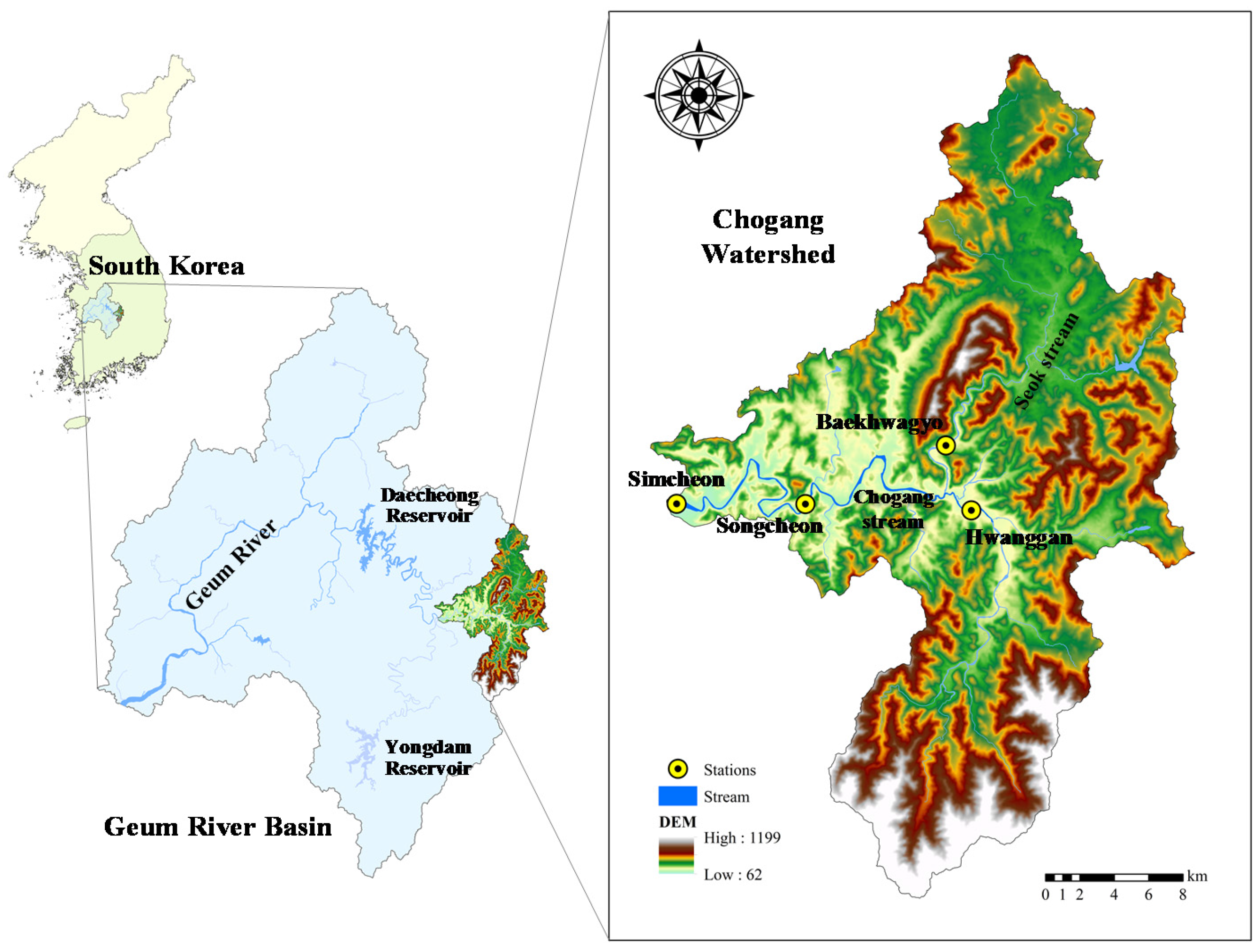
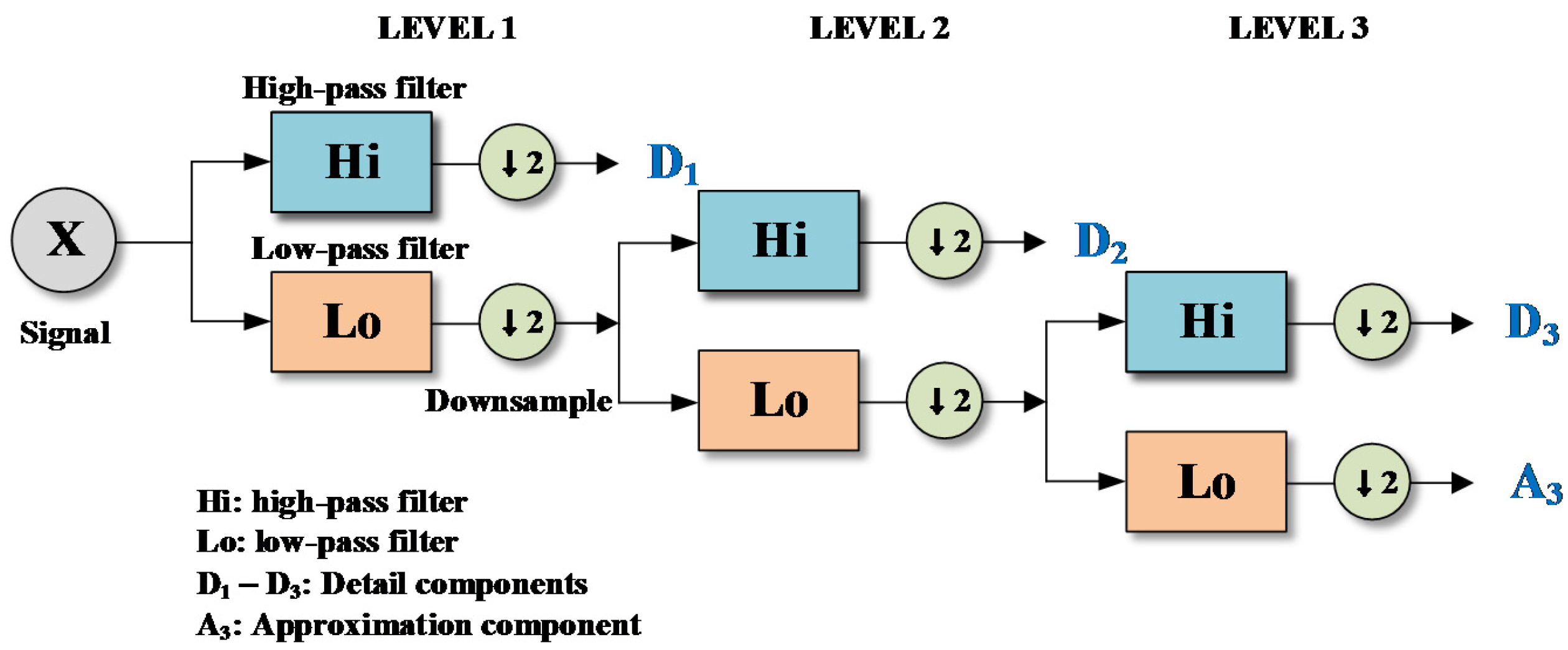
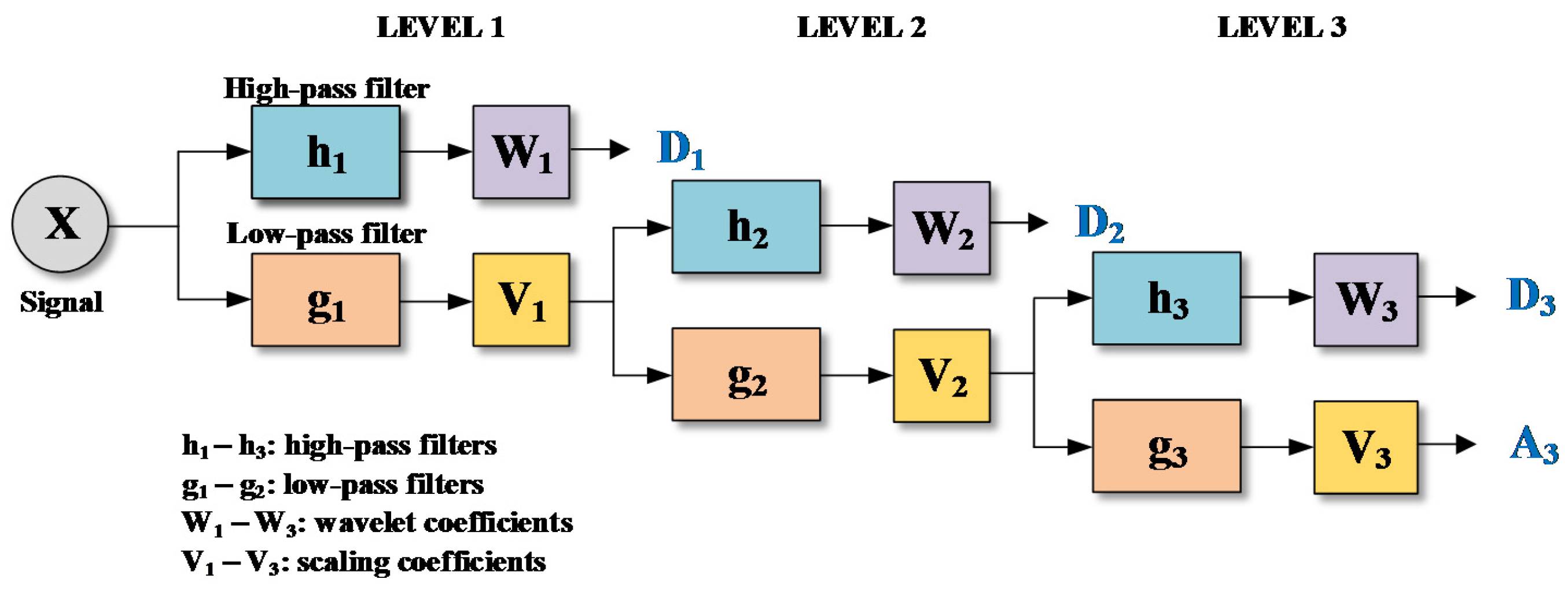
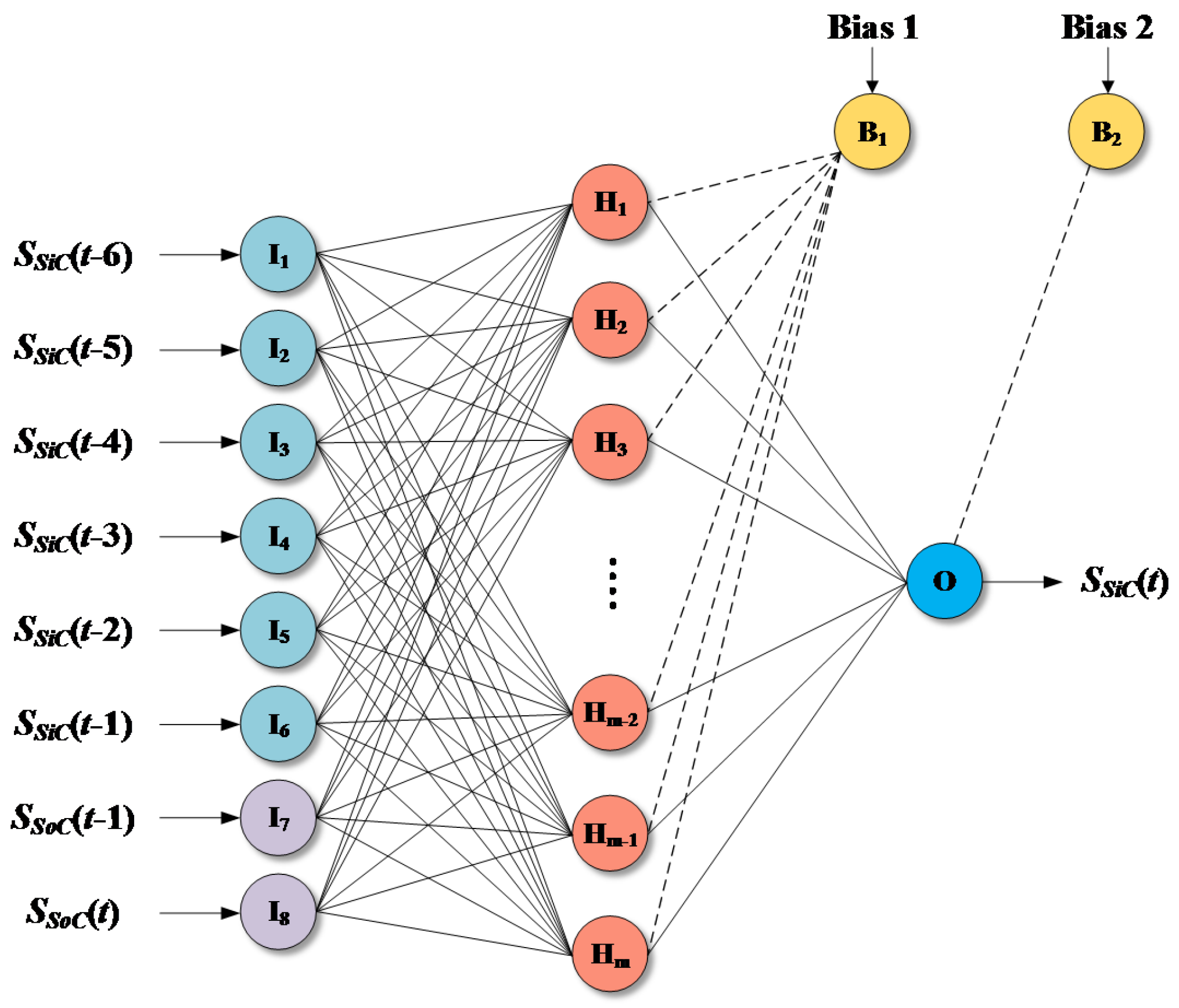
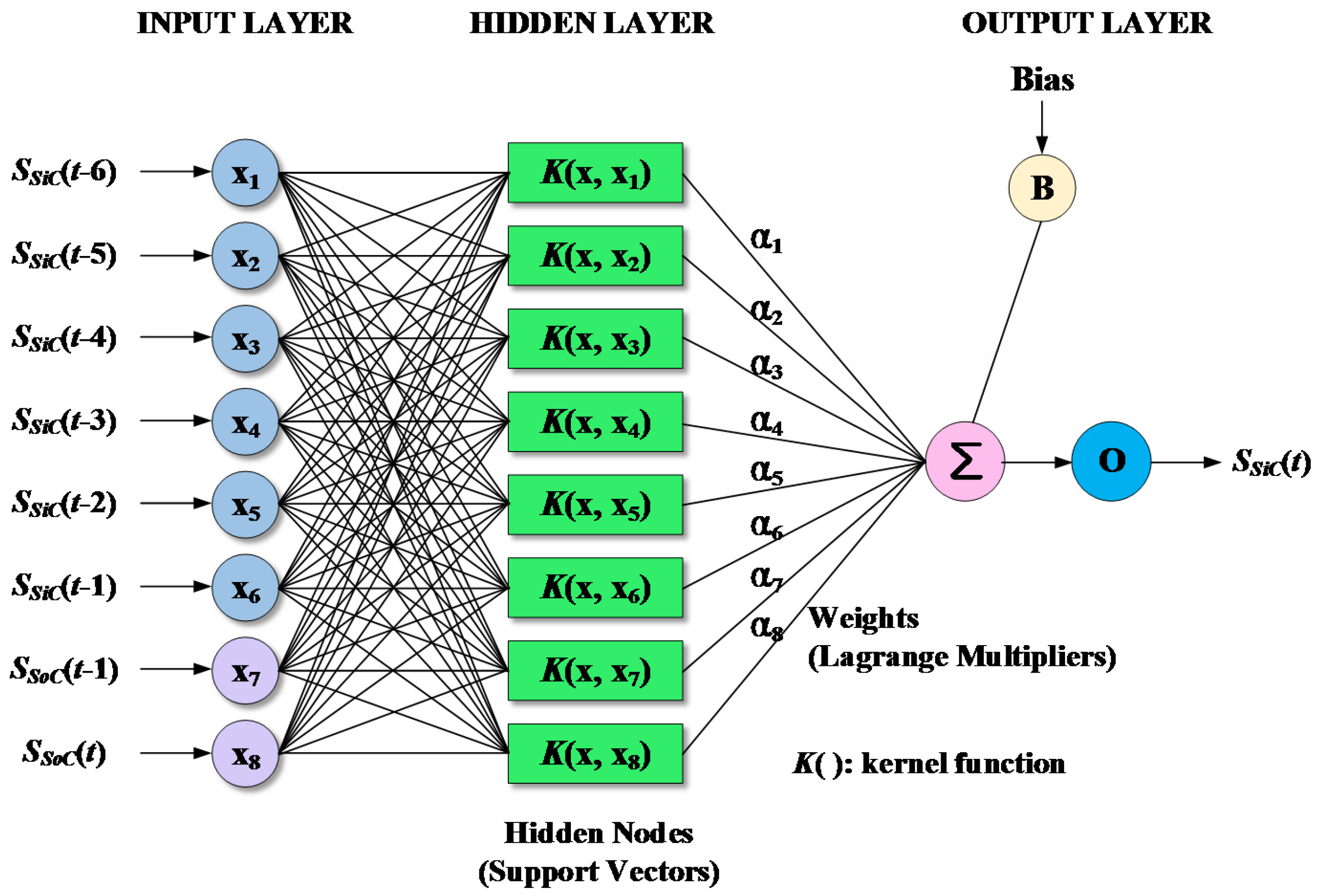

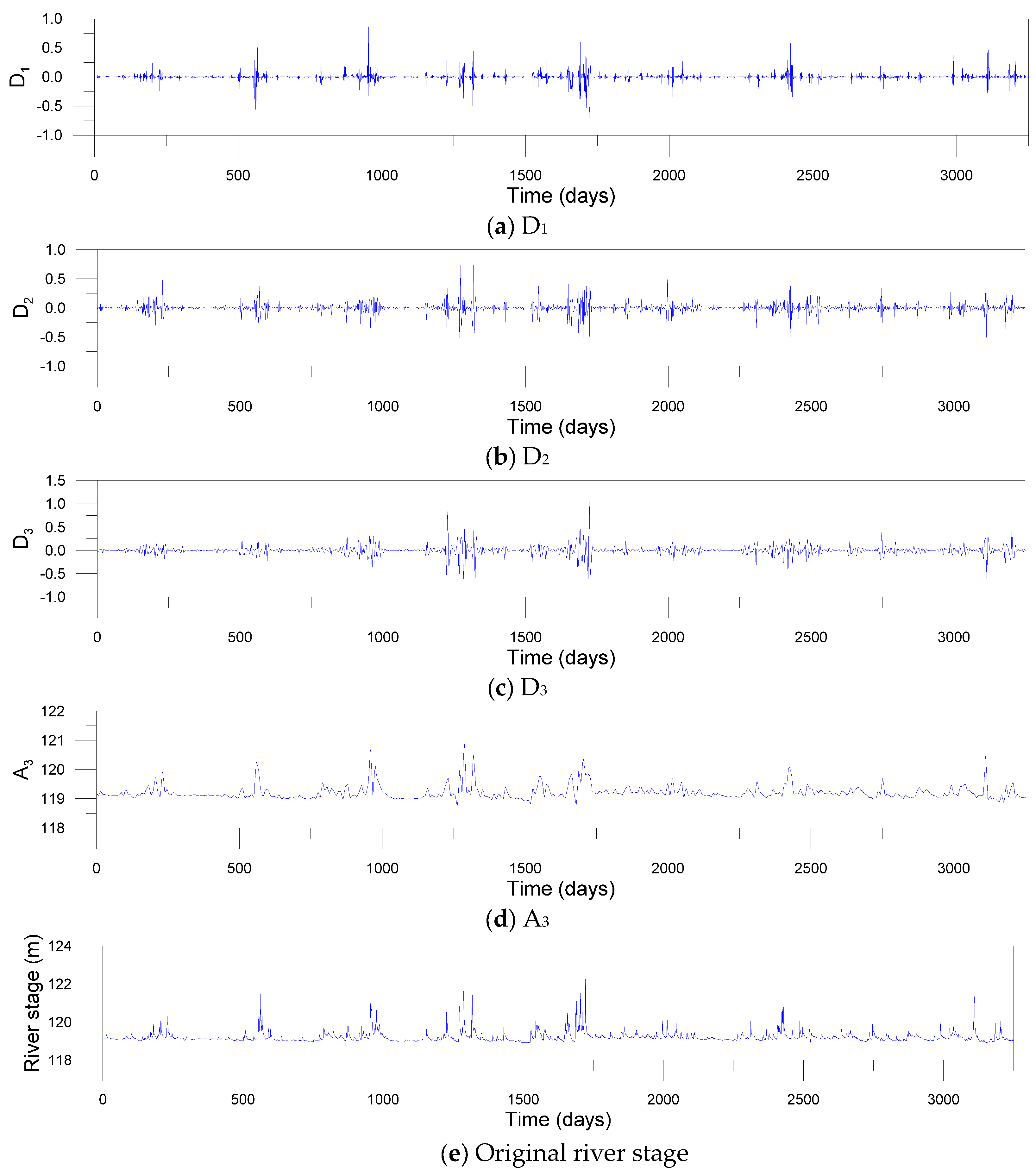


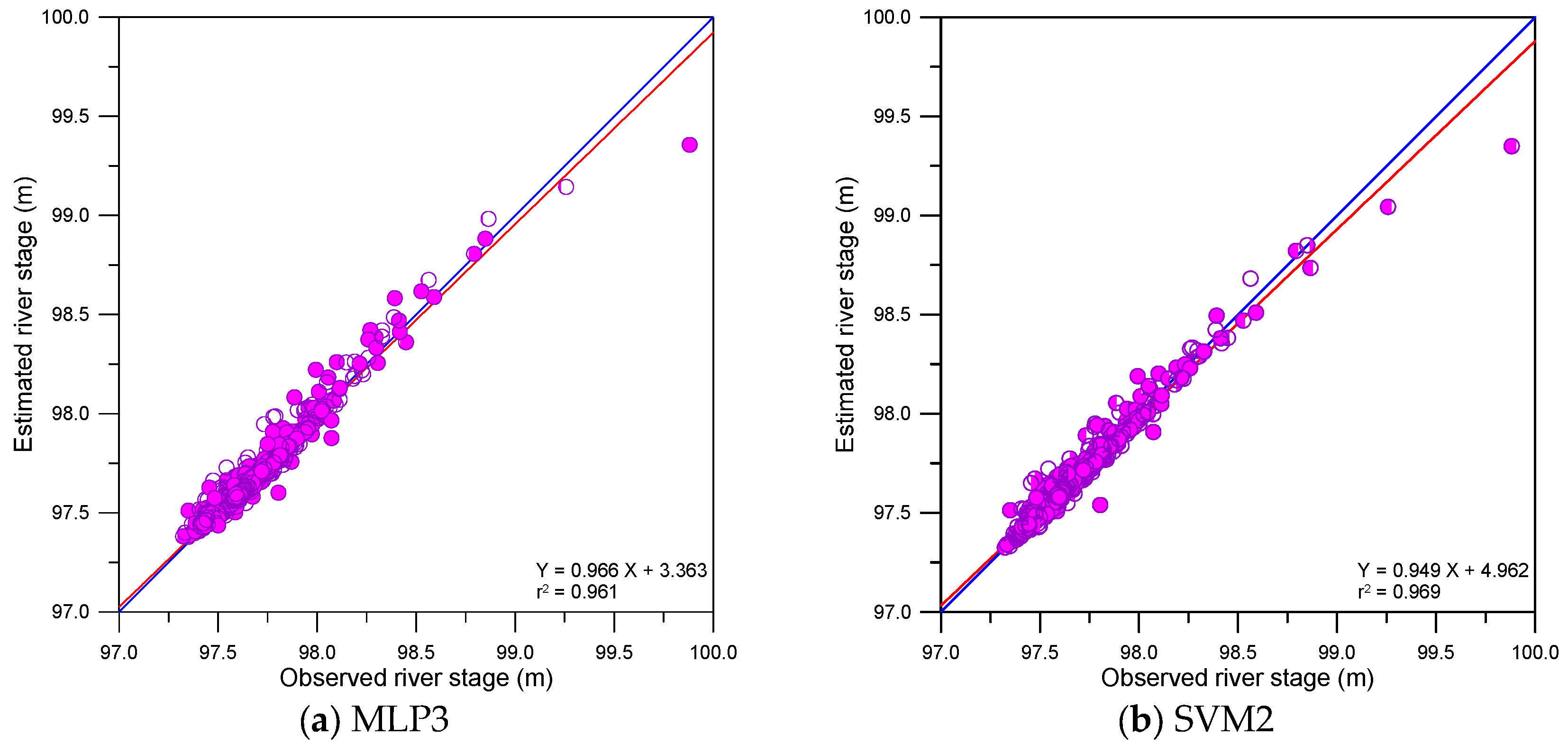
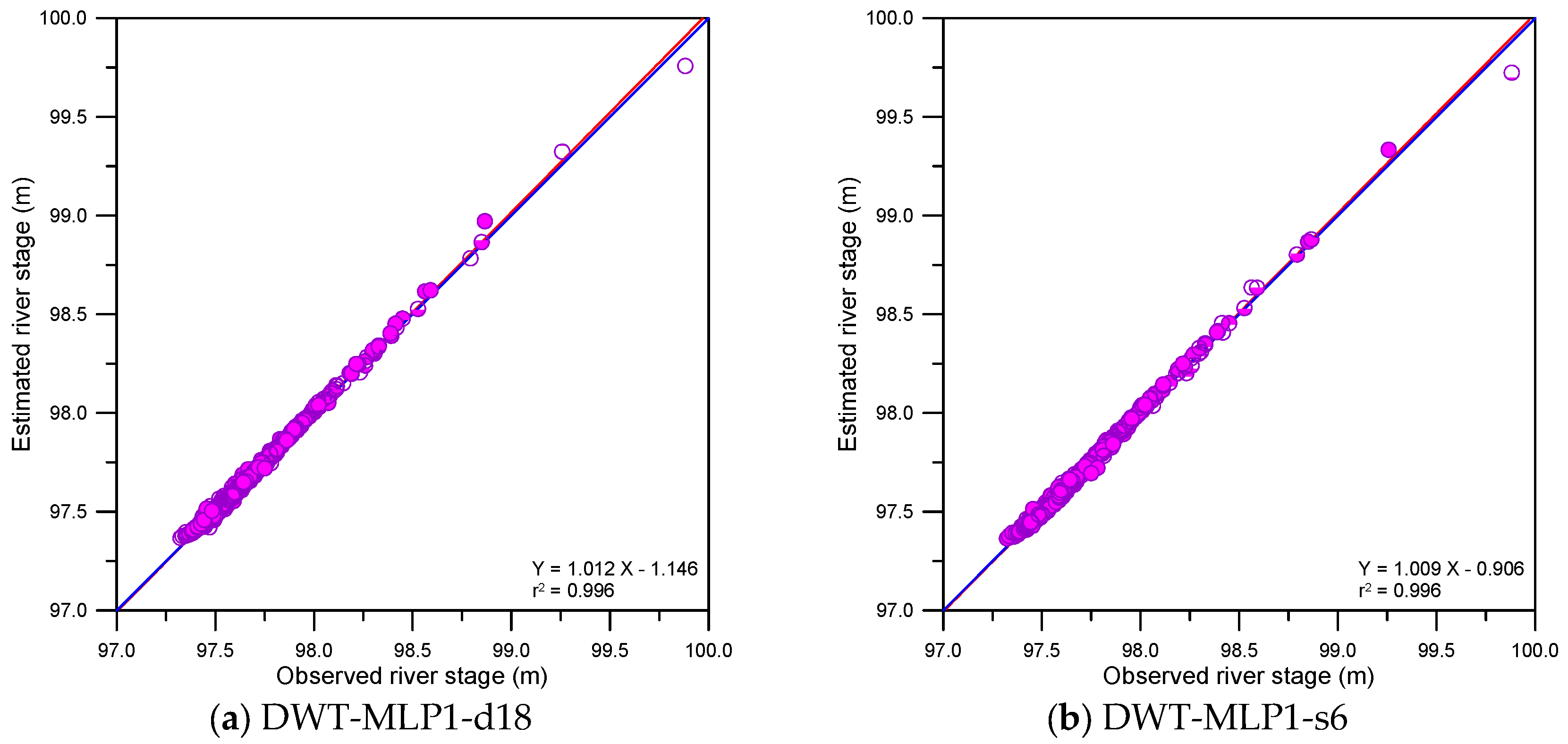

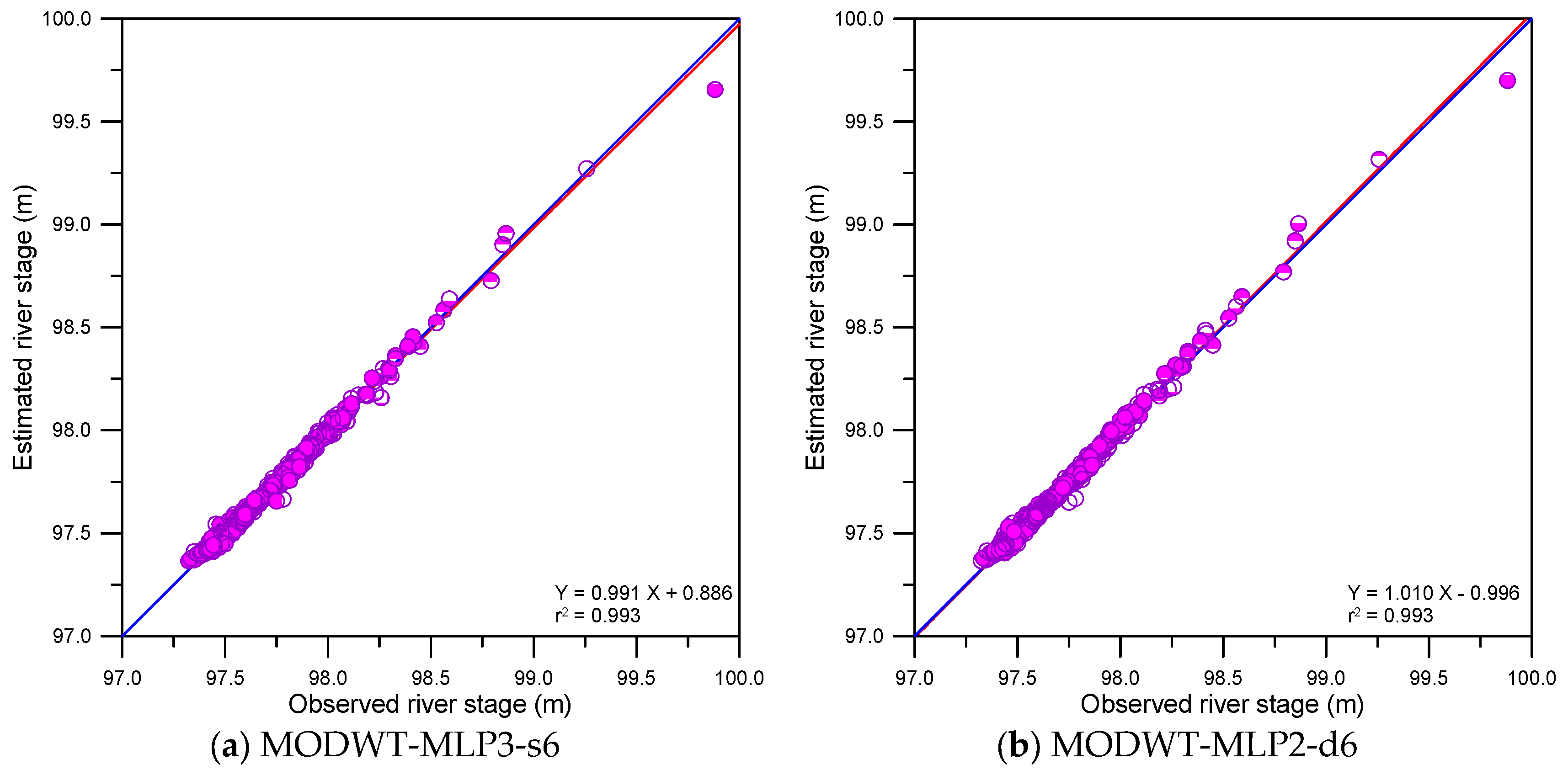


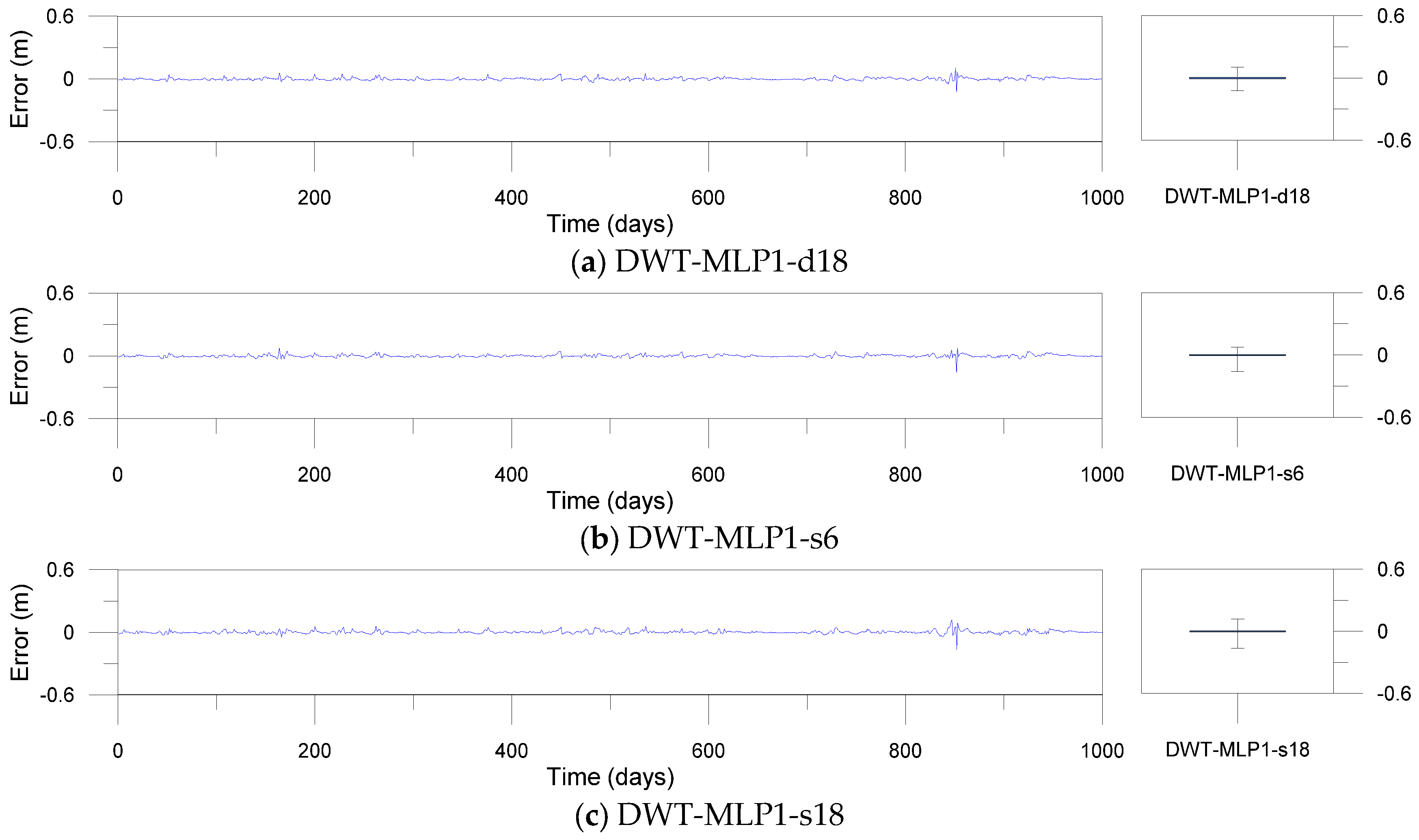

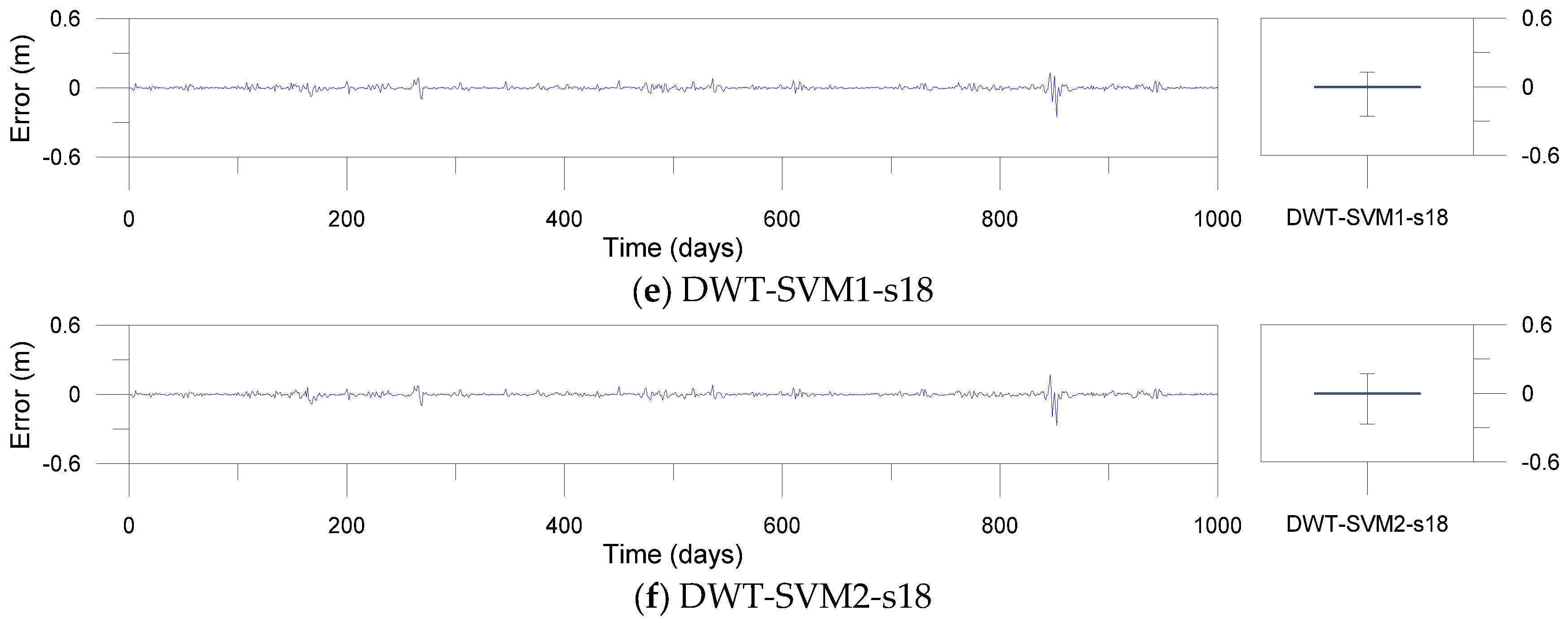
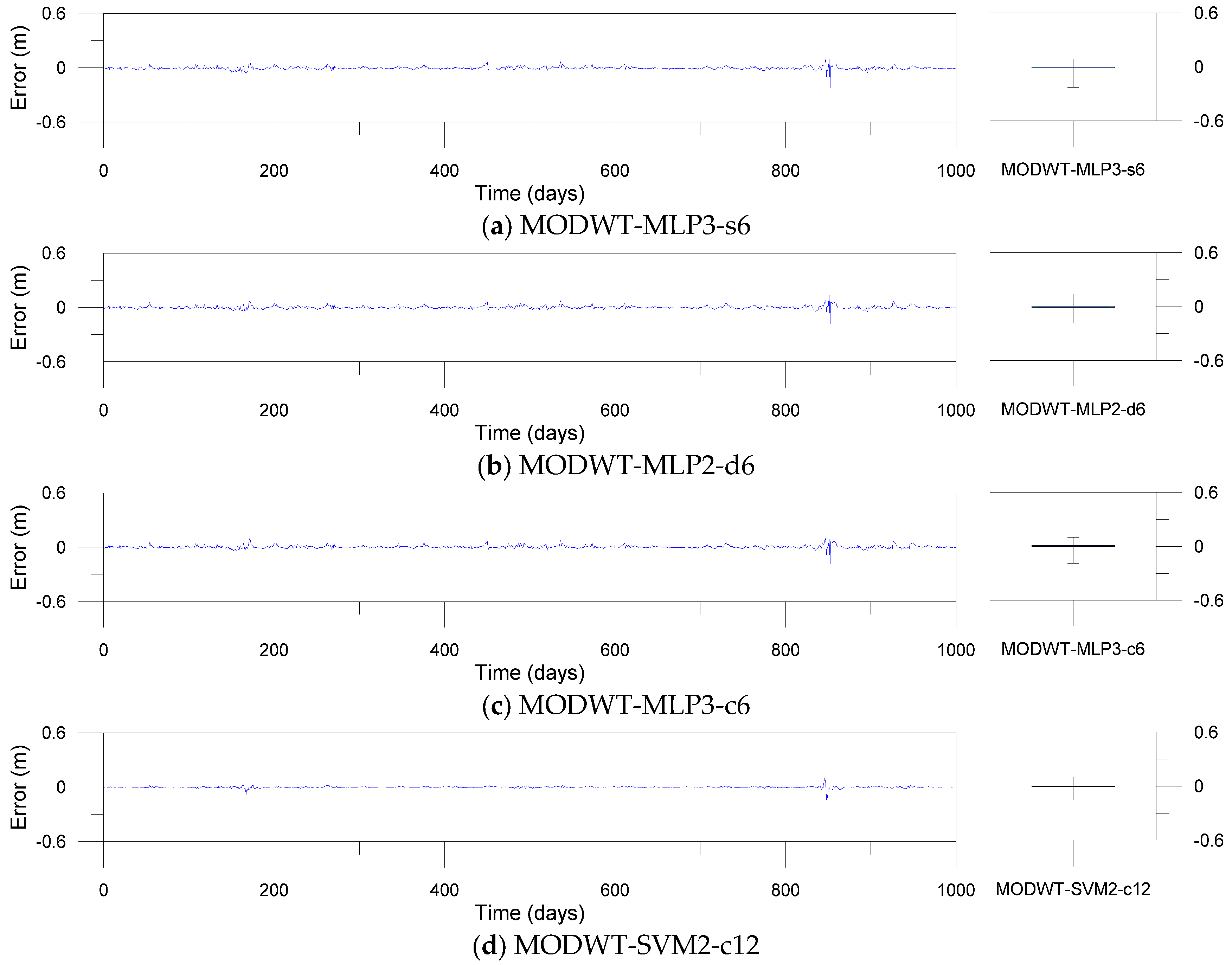


| Input Sets | Input Variables | Output Variables |
|---|---|---|
| Set 1 | SSiC(t-6), SSiC(t-5), SSiC(t-4), SSiC(t-3), SSiC(t-2), SSiC(t-1), SSoC(t-1), SSoC(t) | SSiC(t) |
| Set 2 | SSiC(t-6), SSiC(t-5), SSiC(t-4), SSiC(t-3), SSiC(t-2), SSiC(t-1), SSoC(t-1), SSoC(t), SBH(t-1), SBH(t) | SSiC(t) |
| Set 3 | SSiC(t-6), SSiC(t-5), SSiC(t-4), SSiC(t-3), SSiC(t-2), SSiC(t-1), SSoC(t-1), SSoC(t), SBH(t-1), SBH(t), SHG(t-1), SHG(t) | SSiC(t) |
| Models | CE | d | r2 | RMSE (m) | MAE (m) | MSRE (10−5) | MS4E (10−6 m4) | AARE (%) | TS0.01 (%) | TS0.02 (%) | TS0.05 (%) | TS0.10 (%) | TS0.50 (%) | TS1.00 (%) |
|---|---|---|---|---|---|---|---|---|---|---|---|---|---|---|
| MLP3 | 0.961 | 0.990 | 0.961 | 0.0419 | 0.0243 | 492.090 | 99.187 | 0.025 | 35.7 | 62.8 | 88.3 | 96.2 | 99.9 | 100.0 |
| SVM2 | 0.969 | 0.992 | 0.969 | 0.0374 | 0.0196 | 357.683 | 98.212 | 0.026 | 35.0 | 61.7 | 87.5 | 95.8 | 99.9 | 100.0 |
| DWT-MLP1-d18 | 0.996 | 0.999 | 0.996 | 0.0129 | 0.0089 | 60.130 | 0.482 | 0.009 | 68.0 | 92.1 | 99.4 | 99.8 | 100.0 | 100.0 |
| DWT-MLP1-s6 | 0.996 | 0.999 | 0.996 | 0.0130 | 0.0089 | 54.750 | 0.765 | 0.009 | 68.4 | 91.7 | 99.4 | 99.9 | 100.0 | 100.0 |
| DWT-MLP1-s18 | 0.995 | 0.999 | 0.995 | 0.0153 | 0.0097 | 91.610 | 1.208 | 0.010 | 68.3 | 88.3 | 99.1 | 99.8 | 100.0 | 100.0 |
| DWT-SVM3-c12 | 0.990 | 0.997 | 0.991 | 0.0211 | 0.0117 | 125.750 | 9.914 | 0.012 | 63.2 | 85.3 | 96.9 | 99.5 | 100.0 | 100.0 |
| DWT-SVM1-s18 | 0.989 | 0.997 | 0.990 | 0.0218 | 0.0117 | 119.140 | 9.382 | 0.012 | 64.2 | 84.0 | 97.2 | 99.3 | 100.0 | 100.0 |
| DWT-SVM2-s18 | 0.989 | 0.997 | 0.990 | 0.0221 | 0.0114 | 124.370 | 11.197 | 0.012 | 65.4 | 84.5 | 97.3 | 99.3 | 100.0 | 100.0 |
| MODWT-MLP3-s6 | 0.993 | 0.998 | 0.993 | 0.0177 | 0.0119 | 91.980 | 3.250 | 0.012 | 53.8 | 85.5 | 98.7 | 99.7 | 100.0 | 100.0 |
| MODWT-MLP2-d6 | 0.993 | 0.998 | 0.993 | 0.0178 | 0.0114 | 94.810 | 2.051 | 0.012 | 60.4 | 84.7 | 98.0 | 99.6 | 100.0 | 100.0 |
| MODWT-MLP3-c6 | 0.993 | 0.998 | 0.993 | 0.0178 | 0.0109 | 93.410 | 2.035 | 0.011 | 64.6 | 85.6 | 97.8 | 99.7 | 100.0 | 100.0 |
| MODWT-SVM2-c12 | 0.997 | 0.999 | 0.997 | 0.0113 | 0.0049 | 29.540 | 1.430 | 0.005 | 90.1 | 97.6 | 99.3 | 99.5 | 100.0 | 100.0 |
| MODWT-SVM1-c12 | 0.997 | 0.999 | 0.997 | 0.0118 | 0.0048 | 31.020 | 1.879 | 0.005 | 91.6 | 97.2 | 99.1 | 99.7 | 100.0 | 100.0 |
| MODWT-SVM1-s18 | 0.997 | 0.999 | 0.997 | 0.0115 | 0.0068 | 32.530 | 0.657 | 0.007 | 78.7 | 94.3 | 99.5 | 99.8 | 100.0 | 100.0 |
| Models | CE | d | r2 | RMSE (m) | MAE (m) | MSRE (10−5) | MS4E (10−6 m4) | AARE (%) | TS0.01 (%) | TS0.02 (%) | TS0.05 (%) | TS0.10 (%) | TS0.50 (%) | TS1.00 (%) |
|---|---|---|---|---|---|---|---|---|---|---|---|---|---|---|
| MLP3 | 0.797 | 0.943 | 0.808 | 0.0313 | 0.0195 | 0.0103 | 10.772 | 0.0200 | 43.1 | 68.6 | 91.3 | 98.0 | 100.0 | 100.0 |
| SVM2 | 0.770 | 0.936 | 0.785 | 0.0332 | 0.0209 | 0.0116 | 13.287 | 0.0214 | 41.8 | 66.8 | 89.9 | 97.3 | 100.0 | 100.0 |
| DWT-MLP1-d18 | 0.970 | 0.992 | 0.972 | 0.0120 | 0.0087 | 0.0015 | 0.133 | 0.0090 | 68.3 | 92.0 | 99.7 | 100.0 | 100.0 | 100.0 |
| DWT-MLP1-s6 | 0.973 | 0.993 | 0.976 | 0.0114 | 0.0088 | 0.0014 | 0.086 | 0.0090 | 67.2 | 92.5 | 99.8 | 100.0 | 100.0 | 100.0 |
| DWT-MLP1-s18 | 0.954 | 0.988 | 0.954 | 0.0148 | 0.0097 | 0.0023 | 0.625 | 0.0100 | 67.2 | 87.7 | 99.1 | 99.8 | 100.0 | 100.0 |
| DWT-SVM3-c12 | 0.952 | 0.987 | 0.952 | 0.0152 | 0.0094 | 0.0024 | 0.930 | 0.0096 | 69.4 | 88.6 | 98.3 | 99.8 | 100.0 | 100.0 |
| DWT-SVM1-s18 | 0.958 | 0.989 | 0.958 | 0.0143 | 0.0085 | 0.0021 | 0.768 | 0.0088 | 73.6 | 89.7 | 98.3 | 99.8 | 100.0 | 100.0 |
| DWT-SVM2-s18 | 0.954 | 0.988 | 0.954 | 0.0149 | 0.0085 | 0.0023 | 1.665 | 0.0087 | 74.7 | 89.9 | 98.6 | 99.8 | 100.0 | 100.0 |
| MODWT-MLP3-s6 | 0.958 | 0.989 | 0.965 | 0.0142 | 0.0109 | 0.0021 | 0.259 | 0.0112 | 53.4 | 88.0 | 99.4 | 100.0 | 100.0 | 100.0 |
| MODWT-MLP2-d6 | 0.959 | 0.989 | 0.960 | 0.0141 | 0.0102 | 0.0021 | 0.271 | 0.0104 | 61.3 | 87.7 | 99.2 | 100.0 | 100.0 | 100.0 |
| MODWT-MLP3-c6 | 0.962 | 0.990 | 0.963 | 0.0135 | 0.0089 | 0.0019 | 0.399 | 0.0091 | 69.7 | 90.0 | 99.2 | 99.8 | 100.0 | 100.0 |
| MODWT-SVM2-c12 | 0.992 | 0.998 | 0.992 | 0.0063 | 0.0033 | 0.0004 | 0.174 | 0.0034 | 95.8 | 99.4 | 99.7 | 99.8 | 100.0 | 100.0 |
| MODWT-SVM1-c12 | 0.992 | 0.998 | 0.992 | 0.0064 | 0.0030 | 0.0004 | 0.164 | 0.0031 | 97.5 | 99.5 | 99.5 | 100.0 | 100.0 | 100.0 |
| MODWT-SVM1-s18 | 0.990 | 0.998 | 0.990 | 0.0069 | 0.0047 | 0.0005 | 0.030 | 0.0048 | 88.5 | 98.8 | 99.8 | 100.0 | 100.0 | 100.0 |
| Models | CE | d | r2 | RMSE (m) | MAE (m) | MSRE (10−5) | MS4E (10−6 m4) | AARE (%) | TS0.01 (%) | TS0.02 (%) | TS0.05 (%) | TS0.10 (%) | TS0.50 (%) | TS1.00 (%) |
|---|---|---|---|---|---|---|---|---|---|---|---|---|---|---|
| MLP3 | 0.603 | 0.911 | 0.723 | 0.0385 | 0.0248 | 0.0155 | 29.965 | 0.0253 | 24.7 | 58.7 | 89.4 | 97.5 | 100.0 | 100.0 |
| SVM2 | 0.606 | 0.913 | 0.730 | 0.0383 | 0.0246 | 0.0154 | 27.321 | 0.0252 | 25.8 | 58.3 | 89.8 | 97.2 | 100.0 | 100.0 |
| DWT-MLP1-d18 | 0.977 | 0.995 | 0.984 | 0.0093 | 0.0069 | 0.0009 | 0.051 | 0.0070 | 77.4 | 96.8 | 100.0 | 100.0 | 100.0 | 100.0 |
| DWT-MLP1-s6 | 0.975 | 0.994 | 0.980 | 0.0096 | 0.0066 | 0.0010 | 0.100 | 0.0067 | 80.2 | 95.8 | 99.3 | 100.0 | 100.0 | 100.0 |
| DWT-MLP1-s18 | 0.976 | 0.994 | 0.979 | 0.0095 | 0.0066 | 0.0009 | 0.061 | 0.0068 | 80.9 | 95.4 | 100.0 | 100.0 | 100.0 | 100.0 |
| DWT-SVM3-c12 | 0.875 | 0.970 | 0.898 | 0.0216 | 0.0124 | 0.0049 | 5.589 | 0.0127 | 58.7 | 87.6 | 96.1 | 99.3 | 100.0 | 100.0 |
| DWT-SVM1-s18 | 0.832 | 0.959 | 0.856 | 0.0251 | 0.0129 | 0.0066 | 15.514 | 0.0131 | 56.9 | 84.8 | 97.5 | 98.9 | 100.0 | 100.0 |
| DWT-SVM2-s18 | 0.854 | 0.965 | 0.874 | 0.0234 | 0.0121 | 0.0057 | 11.551 | 0.0124 | 58.7 | 85.5 | 97.5 | 98.9 | 100.0 | 100.0 |
| MODWT-MLP3-s6 | 0.936 | 0.984 | 0.949 | 0.0154 | 0.0100 | 0.0025 | 1.056 | 0.0103 | 63.3 | 90.1 | 98.9 | 99.6 | 100.0 | 100.0 |
| MODWT-MLP2-d6 | 0.946 | 0.987 | 0.951 | 0.0142 | 0.0085 | 0.0021 | 0.989 | 0.0087 | 72.1 | 91.2 | 98.9 | 99.3 | 100.0 | 100.0 |
| MODWT-MLP3-c6 | 0.945 | 0.987 | 0.952 | 0.0143 | 0.0094 | 0.0021 | 0.723 | 0.0096 | 66.1 | 88.7 | 99.3 | 99.6 | 100.0 | 100.0 |
| MODWT-SVM2-c12 | 0.952 | 0.988 | 0.955 | 0.0134 | 0.0057 | 0.0019 | 2.688 | 0.0058 | 88.3 | 97.2 | 99.3 | 99.3 | 100.0 | 100.0 |
| MODWT-SVM1-c12 | 0.950 | 0.988 | 0.953 | 0.0137 | 0.0058 | 0.0020 | 2.914 | 0.0059 | 88.3 | 96.8 | 99.3 | 99.3 | 100.0 | 100.0 |
| MODWT-SVM1-s18 | 0.940 | 0.985 | 0.946 | 0.0149 | 0.0083 | 0.0023 | 2.110 | 0.0084 | 71.7 | 93.6 | 99.3 | 99.3 | 100.0 | 100.0 |
| Models | CE | d | r2 | RMSE (m) | MAE (m) | MSRE (10−5) | MS4E (10−6 m4) | AARE (%) | TS0.01 (%) | TS0.02 (%) | TS0.05 (%) | TS0.10 (%) | TS0.50 (%) | TS1.00 (%) |
|---|---|---|---|---|---|---|---|---|---|---|---|---|---|---|
| MLP3 | 0.921 | 0.979 | 0.921 | 0.0850 | 0.0518 | 0.0741 | 818.660 | 0.0527 | 20.8 | 38.7 | 67.0 | 82.1 | 99.1 | 100.0 |
| SVM2 | 0.927 | 0.981 | 0.928 | 0.0814 | 0.0502 | 0.0679 | 670.961 | 0.0511 | 17.9 | 39.6 | 67.0 | 83.0 | 99.1 | 100.0 |
| DWT-MLP1-d18 | 0.994 | 0.999 | 0.996 | 0.0229 | 0.0152 | 0.0054 | 3.743 | 0.0155 | 40.6 | 80.2 | 96.2 | 98.1 | 100.0 | 100.0 |
| DWT-MLP1-s6 | 0.993 | 0.998 | 0.995 | 0.0245 | 0.0159 | 0.0061 | 6.646 | 0.0162 | 44.3 | 76.4 | 97.2 | 99.1 | 100.0 | 100.0 |
| DWT-MLP1-s18 | 0.992 | 0.998 | 0.993 | 0.0266 | 0.0175 | 0.0072 | 7.794 | 0.0177 | 41.5 | 72.6 | 97.2 | 99.1 | 100.0 | 100.0 |
| DWT-SVM3-c12 | 0.981 | 0.995 | 0.987 | 0.0410 | 0.0237 | 0.0171 | 75.787 | 0.0241 | 37.7 | 59.4 | 90.6 | 98.1 | 100.0 | 100.0 |
| DWT-SVM1-s18 | 0.981 | 0.995 | 0.984 | 0.0412 | 0.0272 | 0.0173 | 45.099 | 0.0277 | 26.4 | 47.2 | 89.6 | 97.2 | 100.0 | 100.0 |
| DWT-SVM2-s18 | 0.978 | 0.994 | 0.984 | 0.0443 | 0.0270 | 0.0201 | 67.891 | 0.0275 | 27.4 | 49.1 | 88.7 | 97.2 | 100.0 | 100.0 |
| MODWT-MLP3-s6 | 0.987 | 0.997 | 0.987 | 0.0348 | 0.0224 | 0.0124 | 27.195 | 0.0227 | 31.1 | 58.5 | 94.3 | 98.1 | 100.0 | 100.0 |
| MODWT-MLP2-d6 | 0.985 | 0.996 | 0.987 | 0.0365 | 0.0263 | 0.0137 | 15.645 | 0.0268 | 23.6 | 49.1 | 87.7 | 98.1 | 100.0 | 100.0 |
| MODWT-MLP3-c6 | 0.984 | 0.996 | 0.986 | 0.0378 | 0.0269 | 0.0147 | 15.432 | 0.0274 | 29.2 | 50.9 | 84.9 | 99.1 | 100.0 | 100.0 |
| MODWT-SVM2-c12 | 0.994 | 0.999 | 0.995 | 0.0230 | 0.0124 | 0.0055 | 5.664 | 0.0126 | 60.4 | 87.7 | 97.2 | 98.1 | 100.0 | 100.0 |
| MODWT-SVM1-c12 | 0.993 | 0.998 | 0.994 | 0.0248 | 0.0131 | 0.0064 | 9.493 | 0.0133 | 64.2 | 84.0 | 96.2 | 99.1 | 100.0 | 100.0 |
| MODWT-SVM1-s18 | 0.996 | 0.999 | 0.996 | 0.0201 | 0.0155 | 0.0042 | 0.570 | 0.0158 | 38.7 | 68.9 | 98.1 | 100.0 | 100.0 | 100.0 |
© 2017 by the authors. Licensee MDPI, Basel, Switzerland. This article is an open access article distributed under the terms and conditions of the Creative Commons Attribution (CC BY) license (http://creativecommons.org/licenses/by/4.0/).
Share and Cite
Seo, Y.; Choi, Y.; Choi, J. River Stage Modeling by Combining Maximal Overlap Discrete Wavelet Transform, Support Vector Machines and Genetic Algorithm. Water 2017, 9, 525. https://doi.org/10.3390/w9070525
Seo Y, Choi Y, Choi J. River Stage Modeling by Combining Maximal Overlap Discrete Wavelet Transform, Support Vector Machines and Genetic Algorithm. Water. 2017; 9(7):525. https://doi.org/10.3390/w9070525
Chicago/Turabian StyleSeo, Youngmin, Yunyoung Choi, and Jeongwoo Choi. 2017. "River Stage Modeling by Combining Maximal Overlap Discrete Wavelet Transform, Support Vector Machines and Genetic Algorithm" Water 9, no. 7: 525. https://doi.org/10.3390/w9070525





